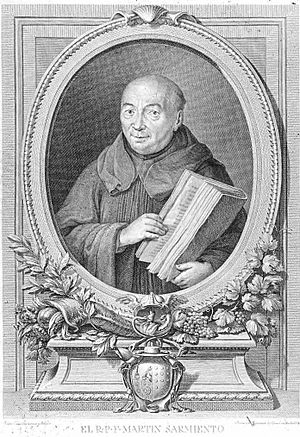Martín Sarmiento facts for kids
Martín Sarmiento (born Pedro José García Balboa) was a Spanish scholar, writer, and Benedictine monk. He was an important figure during the Enlightenment. He was born on March 9, 1695, in Villafranca del Bierzo, Spain, and passed away on December 7, 1772, in Madrid.
Martín Sarmiento wrote about many different subjects. These included Literature, Medicine, Botany (the study of plants), Ethnography (the study of cultures), History, Theology (the study of religion), and Linguistics (the study of language).
His life
When Martín Sarmiento was just four months old, his family moved to Pontevedra. He spent his childhood and teenage years there. On May 3, 1710, at the age of 15, he moved to Madrid. There, he joined the Benedictine order, a group of monks.
He became a priest in 1720. Sarmiento lived in Asturias until 1725, working as a professor in Cebrio and Oviedo. Later, he settled permanently in Madrid. He did travel a few times, including a trip to Toledo to organize books in a big church library. He also visited Galicia three times.
When he was 35, Sarmiento became very interested in languages again. He believed that people often didn't know the true meaning of words. He was especially interested in Spanish and Galician, which are both Romance languages. Sarmiento thought that Galician should be taught in schools. He also believed that priests should learn Galician so they could understand people better during confessions.
In 1745, he went back to Galicia. During this trip, he wrote down the names of places he visited in a notebook. He loved to research where Galician words came from. He even wrote a book in Galician called Colloquium of twenty rustic Galicians. This book helps us understand the Galician language spoken at that time. It includes 1,200 songs sung by a group of Galicians returning from Madrid. The songs talk about the death of King Philip V and describe the celebrations for Ferdinand VI becoming king.
His ideas and interests
Sarmiento was not only interested in languages. He also studied other subjects like botany and medicine. He knew a lot about plants and their health benefits. He cared deeply about improving his country's technical and economic levels, especially with new ideas from the Enlightenment.
Because he knew so much about many different things, he was asked to plan the art and decorations for the Royal Palace of Madrid. Sarmiento designed a big symbolic plan for the palace, showing the history of the Spanish monarchy. It was so complex that only a part of it was ever finished.
He worked with another scholar, Feijoo, to fight against superstition and lack of knowledge. Sarmiento suggested opening libraries in villages. He himself had one of the most important libraries in Spain at that time. Unlike his teacher Feijoo, Sarmiento understood that it was important to know and keep old traditions and popular culture. In this way, he was a great pioneer. He helped research and bring back Galician culture.
Sarmiento passed away at the San Martin convent in Madrid on December 7, 1772. He was 77 years old.
He published two books in memory of Feijoo, including Demostración crítico-apologética del Theatro Crítico Universal in 1732. He wrote many other books, but they were not published during his lifetime.
What he wrote
- Memorias para la historia de la poesía y poetas españoles, (1741-1745), first published in Madrid, 1775.
- Coplas gallegas y Glosario, (1746-...), written in the Galician language.
- Notes on the Privilege of Ordoño and Reflections on Archivists
- Dissertation on the zebra animal, born, raised, known and hunted in ancient Spain
See also
 In Spanish: Martín Sarmiento para niños
In Spanish: Martín Sarmiento para niños


